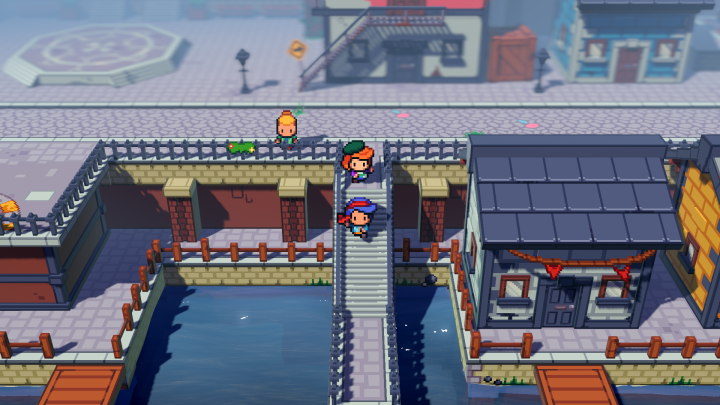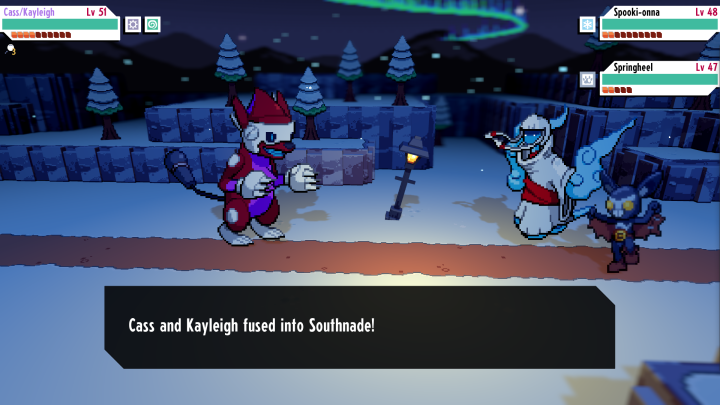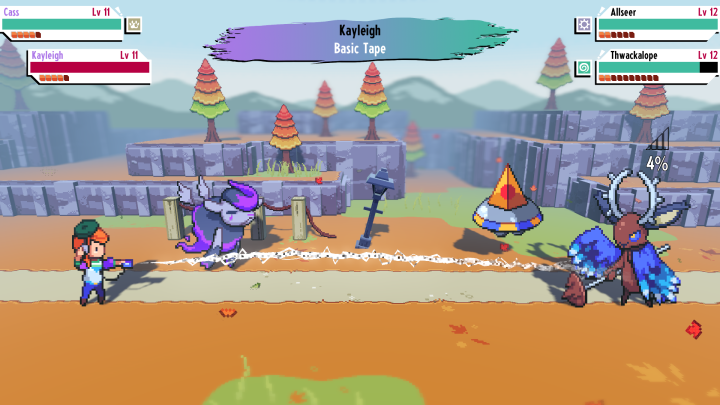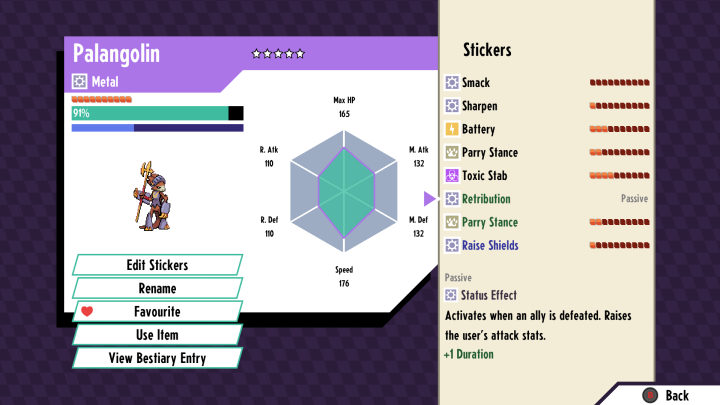Considering how wildly popular the Pokémon franchise is, it always surprises me that it still has no real competition. Plenty of developers have tried to create their own spin on the monster-catching formula, but few have achieved a true mainstream moment. It isn’t for lack of trying either. Games like Temtem worked hard to position themselves as a viable alternative to Nintendo’s juggernaut, but it’s never been enough to work them out of a niche. Anytime a release like that fails to gain large-scale attention, I’m left to ask just what Pokémon has that its peers lack.
It’s a question I’m asking myself once again with the arrival of Cassette Beasts, a new indie monster-catching game that takes direct inspiration from classic Pokémon games. On paper, it has everything a longtime fan could possibly want. All the mechanical staples are there, it’s challenging, and it even tugs at some Game Boy Advance nostalgia with its colorful sprites. Despite playing all the right notes, it still doesn’t quite inspire the same sense of wonder I got with last year’s sloppy Pokémon Violet and Scarlet. So, what gives?
Cassettes Beasts is a key example of how difficult it can be to iterate on an elegant and familiar formula. It shines when it comes to its original ideas, including its musical aesthetic, a creative monster-fusion hook, and exploration that invokes the very first Legend of Zelda game. It struggles a bit more when trying to remix established Pokémon systems, making each far more complicated in the process. It all makes for another monster-catcher that offers plenty of nostalgic fun, but still emphasizes why Pokémon perseveres even when it’s in the red.
Tapes and tapes
On its surface, Cassettes Beasts doesn’t seem like it needs much explaining. Players are let loose in a world full of monsters that can be caught and used to fight in turn-based RPG battles. Beasts have different elemental types that play into a “rock, papers, scissors” battle system and some can be evolved. Just about everything you expect from a Pokémon-style game is present, though there are key differences to each system that take some getting used to.

Some of those changes help it stand on its own and give it a distinct voice. For instance, its entire combat system is built on cassette tapes. At the start of the game, players get a Walkman that holds their monsters and acts as a clever bit of UI during battles. Pokéballs are tapes here and beasts need to be “recorded” during a fight to capture them. Once that’s done, they’ll be committed to cassettes and summoned when slotted into the Walkman. It’s a clever motif, and developer Bytten Studio has a lot of fun adapting genre staples to it. Moves, for instance, are represented as stickers that can be stuck to a tape or peeled off.
There’s a lot to love on an aesthetic level. Its original soundtrack, for instance, delivers a strong collection of low-key pop songs and ambient overworld themes filled with slick guitar work. It’s a total treat on the visual side as well, striking a balance between a Game Boy Advance Pokémon game and Earthbound. I especially love a lot of the monster designs here, which benefit from colorful, detailed sprite work. Some personal favorite monsters include a hermit crab with a traffic cone for a shell and a carousel of rats.
Those monsters tie into its ace-in-the-hole system: merging. Once a special bar has filled up, players can fuse two of their equipped monsters together during a battle to create a mash-up monster. It’s a delightful magic trick that plays on the viral nature of Pokémon fusion generators. There’s always a surprise in store when smashing two creatures together and seeing the wild sprite they form into. It makes the collection of possible beasts feel limitless (there are a whopping 14,000 or so combos here), providing a lot of incentive to experiment with different creatures, rather than sticking to six favorites.

Its approach to exploration is a highlight as well. Rather than following the genre’s route-to-city formula, Cassette Beasts is a more open-ended game that feels spiritually aligned with The Legend of Zelda. It’s a secret-filled overworld, with tons of hidden caves and environmental puzzles that can be discovered from the jump. Some mainline quests prompt players to track down musical instruments, beat gym leader-like rangers, and beat up some landlords (who hilariously stand in as the game’s version of Team Rocket), but there’s no established order or guidance beyond that. It’s the one area where it really has an advantage over Pokémon, getting at Violet and Scarlet’s open-world idea in a much cleaner, rewarding fashion.
If you come at Cassette Beasts as more of a classic adventure game, it’s easy to vibe with its laid-back style and nonlinear questing. It’s the more explicit Pokémon DNA that left me in desperate need of an old -school strategy guide.
Iterating on perfection
So many of Cassette Beasts’ systems are so complicated that I’m having trouble breaking them down succinctly here. For starters, the trainer has a health bar just like monsters do. Any time a beast is knocked out, any damage that would’ve gone to it that turn is delivered to the trainer instead. That means that players need to keep an eye on each creature’s health and their own, adding a fun, though complicated twist to an established battle formula.
On top of that, the whole combat system is built around double battles, as players always have a companion at their side, in addition to six beasts. Even the shortest trainer battles feel a little long as a result, with players having to wait through three or four monster attack animations instead of two every battle. The duo system plays into its somewhat confusing catching system too, where one character needs to record a monster during a turn while the other weakens it to alter its chance of being caught (explicitly shown as a percentage). It’s always nice to see developers put their own spin on Pokémon ideas, but the record system winds up feeling like an overly complex way to get around having a character simply toss a ball.

That feeling especially rears its head when it comes to monster types, which finds Cassette Beasts at its most overbaked. Like Pokémon, beasts here have different types that are strong against some types and weak against others. Familiar types like fire and ice appear alongside ones like plastic and wind. The combat system goes one step farther though, as types have a much more tangible effect on one another. Shooting a fire attack at a wind creature allows it to summon an updraft that acts as a shield. Hitting a steel monster with a rock attack, on the other hand, triggers a resonation status effect that’ll cause an instant death after three hits.
Every single type combination has an interaction like this and they are extremely difficult to keep straight. I continuously feel punished for not being able to commit each to memory, with incorrect attacks often giving enemies major buffs that put me at a disadvantage for the rest of battle. That system brings a lot of visual clutter to battles too, with tons of tiny status icons dotting the screens and waves of extra text extending already long battles. Those who’ve always wanted more complexity from Pokémon’s battle system will have a lot to dig into, but it makes for a steep learning curve that I still have yet to nail down.

As I struggled to adapt to systems like this, I began to wonder if I simply was too comfortable with an established system I’ve been familiar with for years. Perhaps I wasn’t meeting Cassette Beasts on its own terms as a totally new spin on the monster-catching formula. I do figure there’s some level of truth to that, but the complicated systems made me appreciate how elegantly Pokémon handles a complex idea. It’s no small task. We’re talking about an RPG with hundreds of distinct monsters to balance, 18 types to work around, and a myriad of under-the-hood systems like effort values and natures that make it all tick. And yet, it works. Pokémon games are incredibly easy to understand, to the point where young kids can pick it up and figure it out without a guide. It still maintains a ridiculous amount of depth, though, fueling a hardcore competitive scene that operates on an entirely different level from casual players.
A lot of Pokémon riffs seem to operate under this idea that they’re going to fix the series’ problems or provide an experience that’s more geared toward the adults who grew up on the series. Both are noble causes, but they’re easier said than done. Temtem, for instance, tries to create a “dream” Pokémon MMO, but it struggles when it comes to cluttered design and bland creatures that highlight how good Game Freak is at its job. The truth is that Pokémon still thrives because its developers have it down to a science at this point, streamlining potential pain points with each game and delivering a continually inventive cast of monsters.
Cassette Beasts does fall into some familiar pitfalls, making for a hit-and-miss adventure. Some might find its complexity appealing, but that comes at the expense of casual appeal and legibility. Still, I’m encouraged by how many of its original ideas land. Monster fusion is a truly impressive trick, exploration feels classic and modern in the same breath, and its cassette motif is a clever bit of theming that gives it a distinct style. Perhaps Game Freak should be the one taking notes this time.
Cassette Beasts is out now on PC and is coming to consoles later this spring.



